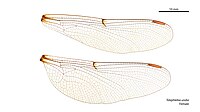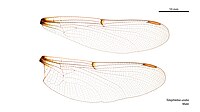Telephlebia undia
Appearance
| Carnarvon evening darner | |
|---|---|
| Scientific classification | |
| Domain: | Eukaryota |
| Kingdom: | Animalia |
| Phylum: | Arthropoda |
| Class: | Insecta |
| Order: | Odonata |
| Infraorder: | Anisoptera |
| Family: | Aeshnidae |
| Genus: | Telephlebia |
| Species: | T. undia
|
| Binomial name | |
| Telephlebia undia Theischinger, 1985[2]
| |

| |
Telephlebia undia is a species of dragonfly in the family Telephlebiidae,[3] known as the Carnarvon evening darner.[4] It is a medium to large, dark chestnut brown dragonfly with dark markings on the leading edge and base of its wings.[5] It is endemic to the vicinity of Carnarvon National Park in Central Queensland, Australia, where it inhabits streams near waterfalls,[6] and flies at dusk.[5]
Telephlebia undia appears similar to Telephlebia tryoni.[4]
Gallery
-
Female wings
-
Male wings
See also
References
Wikimedia Commons has media related to Telephlebia undia.
- ^ Dow, R.A. (2017). "Telephlebia undia". IUCN Red List of Threatened Species. 2017: e.T14260012A59256468. doi:10.2305/IUCN.UK.2017-1.RLTS.T14260012A59256468.en.
- ^ Theischinger, G. (1985). "A revision of the Australian genus Telephlebia Selys (Odonata: Aeshnidae: Brachytroninae)". Australian Journal of Zoology. 33 (2): 245–261 [254]. doi:10.1071/ZO9850245.
- ^ "Species Telephlebia undia Theischinger, 1985". Australian Faunal Directory. Australian Biological Resources Study. 2012. Retrieved 20 March 2017.
- ^ a b Theischinger, Günther; Hawking, John (2006). The Complete Field Guide to Dragonflies of Australia. Collingwood, Victoria, Australia: CSIRO Publishing. p. 146. ISBN 978-0-64309-073-6.
- ^ a b Watson, J.A.L.; Theischinger, G.; Abbey, H.M. (1991). The Australian Dragonflies: A Guide to the Identification, Distributions and Habitats of Australian Odonata. Melbourne: CSIRO. ISBN 0643051368.
- ^ Theischinger, Gunther; Endersby, Ian (2009). Identification Guide to the Australian Odonata (PDF). Department of Environment, Climate Change and Water NSW. p. 239. ISBN 978-1-74232-475-3.



